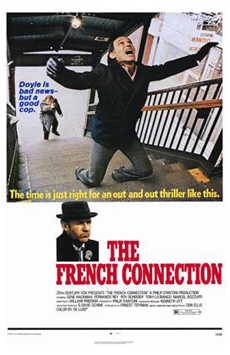As the movie begins, we meet Jimmy "Popeye" Doyle (Hackman)
and Detective Buddy Russo (Scheider) in the midst of a bust. They arrest
a smalltime criminal, hoping it will lead to something bigger. When
that leads nowhere, they follow some suspicious underworld figures out
of a bar, until they stumble on enough evidence to seek a warrant and
an arrest.
Therein lies the difference between The French Connection and
most other police movies. Popeye Doyle and his partner are not searching
for answers to a specific crime. Rather, they're just striving to make
an impressive-enough bust to look good for both them and the department.
Driven by these somewhat selfish motives, Doyle often skirts the rules.
His clumsy, brutish style of police work runs contrary to the usual
cinematic cop.
Hackman's portrayal won both praise and a Best Acting Oscars. As his
long-suffering partner, Scheider is the perfect foil: a by-the-books
officer wearied by his partner's convention-flouting ways. Although
his character is less memorable, he's important to the story, if for
no other reason than to provide some context for Doyle's behavior. Their
acting was partially informed by time they'd spent patrolling with police
officers Eddie Egan and Sonny Gross, whose exploits inspired the book
and movie. This experience opened the actor's eyes to the reality of
patrolling the streets.
The use of real police officers and transit workers to play roles in
the film also added to the film's authenticity. The performers also
frequently used terms and phrases given to them by police advisors during
rehearsals.
Much of the movie is shot on location in New York City, and one of
the most famous chase scenes of all time (the culmination of which appeared
on the movie posters), follows Boyle on a high-octane race against time,
in a commandeered car trying to catch up with a suspect on the West
End elevated subway line! Incidentally, the realism of that chase was
helped by an unplanned car crash, which fortunately resulted in no injuries.
The producers paid the car owner for the repairs to his vehicle. The
chase sequence was widely regarded as the best up to that time and ranks
high even today amongst action aficionados.
Despite a few such moments, the movie is often plodding. Much like
real police work, it is full of false leads and waiting. Because of
that, however, it may be one of the most accurate police films ever
made.


